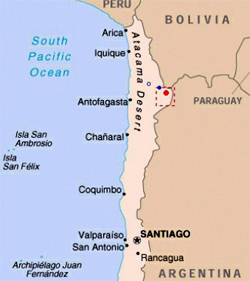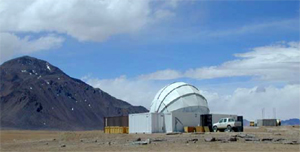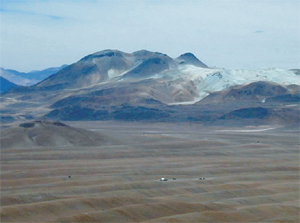|
|
|
|
| |
 The site proposed for the QUIET telescopes is the Chajnantor scientific reserve in Chile, at an altitude of 5080 m. This site is recognized as one of the best in the world for millimeter and submillimeter astronomy. The site belongs to the state of Chile and is leased to the international Atacama Large Millimeter Array project (ALMA). Construction of ALMA has recently started, but several other projects have already obtained excellent results at or near the site: the MAT/TOCO and MINT CMB experiments, the CBI interferometer, and the ASTE (Japan) and APEX (ESO) single-dish antennas. We have chosen this site for several reasons:
The site proposed for the QUIET telescopes is the Chajnantor scientific reserve in Chile, at an altitude of 5080 m. This site is recognized as one of the best in the world for millimeter and submillimeter astronomy. The site belongs to the state of Chile and is leased to the international Atacama Large Millimeter Array project (ALMA). Construction of ALMA has recently started, but several other projects have already obtained excellent results at or near the site: the MAT/TOCO and MINT CMB experiments, the CBI interferometer, and the ASTE (Japan) and APEX (ESO) single-dish antennas. We have chosen this site for several reasons:
- Atmosphere The atmospheric conditions in the Atacama desert are among the best in the world, with only the South Pole being comparable.
- Infrastructure We have access to the existing CBI infrastructure, including a telescope platform suitable for our large-scale experiment.
- Logistics The site is accessible at all times of the year. It is about a 1 hour drive from the town of San Pedro de Atacama, where comfortable accommodations can be obtained, and about 2 hours from the airport at Calama which has international connections via Santiago.
- Sky Coverage Since the site is located at latitude 23oS, we can view a substantial portion of both the northern and southern hemisphere skies, facilitating comparisons with other experiments. Overlapping coverage with bolometer arrays operating at higher frequencies will help in separating foreground contaminants and will provide a check on systematic errors, which are quite different for bolometric and coherent polarimeters.
- Scan Strategy Cross-linking scan strategies like the one developed for QUIET that minimize systematic errors are possible from this (non-polar) site without changing elevation or rotating about the optical axis.
|
| |
|
|
| |
 We plan to use the extensive existing infrastructure of the CBI project. The CBI has its own power plant consisting of a pair of identical 230 kVA diesel generators; one of these is sufficient to power all the QUIET telescopes operating simultaneously, while the second provides backup with automatic switch-over. Fuel consumption is ~15 m3 per month. The buildings at the CBI site are standard ISO shipping containers that are insulated and fitted with oxygenators, heaters and air conditioners, power and lights. The site has a control room, laboratory, 2 bedrooms, bathroom, machine shop and several unfitted storage containers. Although it is quite possible and almost comfortable to spend periods of several days at the site, during routine operations engineers and observers usually sleep at the base in San Pedro de Atacama. The laboratory includes full facilities for making repairs and testing equipment. The oxygen concentration in the control room, laboratory and bedrooms is increased to ~27% to provide an equivalent altitude of about 3500 m. Oxygen is extracted from the outside air using molecular sieves. For outside work, portable bottled oxygen systems are used. Experience with the CBI has shown that supplemental oxygen greatly increases human efficiency.
We plan to use the extensive existing infrastructure of the CBI project. The CBI has its own power plant consisting of a pair of identical 230 kVA diesel generators; one of these is sufficient to power all the QUIET telescopes operating simultaneously, while the second provides backup with automatic switch-over. Fuel consumption is ~15 m3 per month. The buildings at the CBI site are standard ISO shipping containers that are insulated and fitted with oxygenators, heaters and air conditioners, power and lights. The site has a control room, laboratory, 2 bedrooms, bathroom, machine shop and several unfitted storage containers. Although it is quite possible and almost comfortable to spend periods of several days at the site, during routine operations engineers and observers usually sleep at the base in San Pedro de Atacama. The laboratory includes full facilities for making repairs and testing equipment. The oxygen concentration in the control room, laboratory and bedrooms is increased to ~27% to provide an equivalent altitude of about 3500 m. Oxygen is extracted from the outside air using molecular sieves. For outside work, portable bottled oxygen systems are used. Experience with the CBI has shown that supplemental oxygen greatly increases human efficiency.
A paved highway leads to within 14 km of the site with a graded gravel road for the remainder. In addition, 130 km away the city of Calama offers supermarkets and hardware, electronics, and lumber stores. Antofagasta, a large port city is located 275 km away. Fedex, UPS and other courier services deliver regularly to San Pedro, and small pieces of equipment can be sent by airfreight to Calama.
For QUIET we plan to install a 10 Mbit/s radio link from the CBI site to San Pedro to enable remote operations. This will allow us to minimize the number of person-hours spent on the site each day and reduce operations costs.
|
| |
|
|
| |
 The Chajnantor site is one of the world's premier locations for millimeter and sub-millimeter observations. The combination of high altitude and exceptionally low water vapor, result in minimal atmospheric noise. Extensive meteorological and atmospheric studies have been performed at the site in preparation for CBI, APEX, ASTE and ALMA. Several years of data have been obtained with a 183 GHz water vapor radiometer, a 225 GHz and 350 µm tipping radiometers among others. The results are summarized in Chapter 14 of the ALMA Project Book.
The Chajnantor site is one of the world's premier locations for millimeter and sub-millimeter observations. The combination of high altitude and exceptionally low water vapor, result in minimal atmospheric noise. Extensive meteorological and atmospheric studies have been performed at the site in preparation for CBI, APEX, ASTE and ALMA. Several years of data have been obtained with a 183 GHz water vapor radiometer, a 225 GHz and 350 µm tipping radiometers among others. The results are summarized in Chapter 14 of the ALMA Project Book.
Our estimates of the zenith noise temperature have been obtained using the data from ALMA as input to a standard atmospheric model. We estimate a zenith temperature of less than 4K, for 80% of nights, at both 40 and 90 GHz. While this noise is unmatched by any terrestial observation site, zenith temperature is not the primary concern for CMB experiments.
Atmospheric stability is of greater concern as it results in excess noise which not always stationary. For QUIET, any polarized fluctuations are of primary concern. The fluctuating part of atmospheric emission is caused mostly by fluctuating water vapor. The CBI site has very low water vapor and on 2/3 of nights has a relative humidity less than 30%.
Perhaps the best measure of the site quality, is from the CBI data. CBI samples angular scales of interest with different baselines. The shortest baseline which samples scales closest to QUIET large scale, does not detect atmospheric intensity fluctuations on 85% of nights. The longest baselines, sampling a scale close to the small scale observations, do not detect atmospheric fluctuations. It is important to note that for polarized fluctuations (Q or U), CBI did not detect the atmosphere on any baseline. Based upon these data and the CAPMAP results at sea level, we do not expect polarized atmospheric fluctuations to be a limitation for QUIET.
Finally, experience with the CBI operating over the last 5 years has been that less than 15% of the data (recorded between sunset and sunrise) have to be discarded due to significant increase in the noise. The bad data are almost always associated with visible cloud cover, and most of the losses occur in the January - March "Bolivian winter". To minimize the lost time, we will schedule instrument installations and upgrades in the January - March period as far as possible.
|
| |
|
|